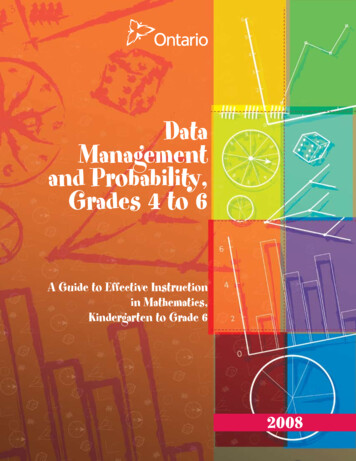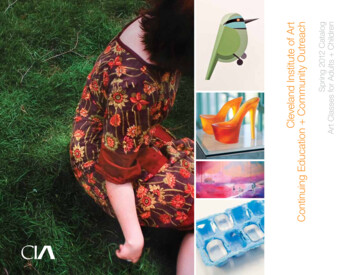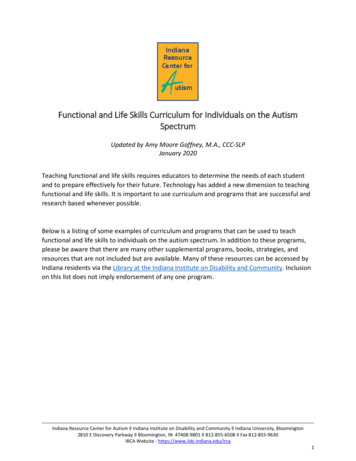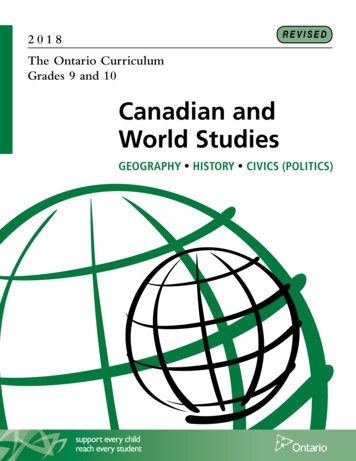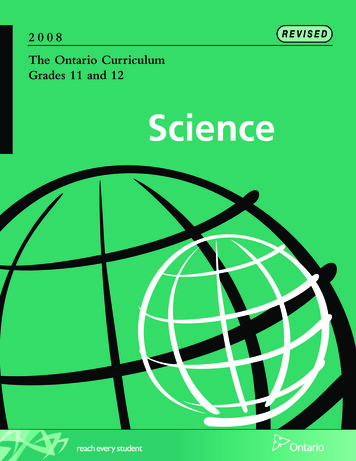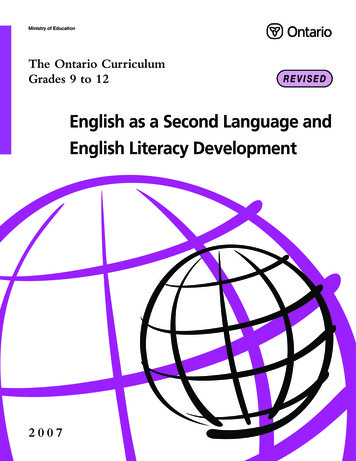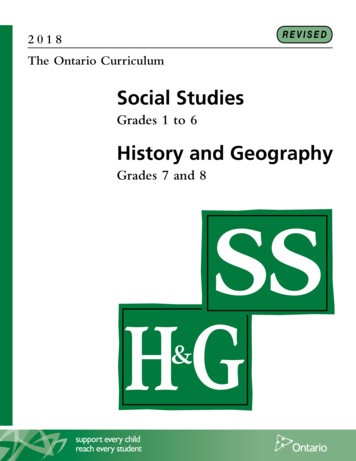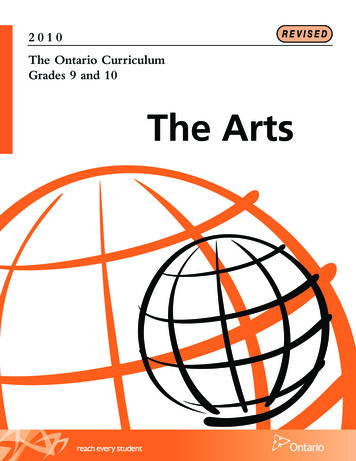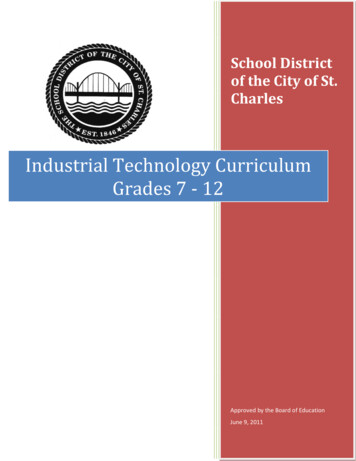
Transcription
School Districtof the City of St.CharlesIndustrial Technology CurriculumGrades 7 - 12Approved by the Board of EducationJune 9, 2011
Committee MembersKevin Dill, Industrial Technology Teacher, SCHSJeremy Jackson, Industrial Technology Teacher, SCWMike Zacheis, Industrial Technology Teacher, SCHSBrian Kirton, Industrial Technology Teacher, HardinAndrew Stewart, Asst. Principal, SCWDanielle Tormala, Ed.D., Associate Superintendent,Curriculum & Instruction
Table of ContentsDistrict Mission, Vision, Values, and Goals .4Philosophical Foundations . .5Course Descriptions .6-7Industrial Technology Rational .8-9Essential Understandings .10-12Program Goals 13Scope and Sequence .14-16Individuals Courses1. 7th Grade Industrial Technology . 172. 8th Grade Industrial Technology . 223. Graphic and Electronic Media .254. Architectural Drafting & Design .305. Mechanical & Computer Aided Drafting 366. Design & Machine Processes . 457. Advanced Design & Machine Processes . .538. Advanced Technological Solutions .589. Home Repairs . 6310.Transportation Systems . 69Appendix 75Missouri Performance (Process) Standards .76Missouri Knowledge (Content) Standards . .78National Technology Educational Content Standards . .80
District MissionThe School District of the City of St. Charles believes that teaching and learning are the two mostimportant activities that occur in our community. Our mission is to provide the care, leadership,and instructional skills necessary to ensure that effective learning occurs for each studentDistrict VisionThe City of St. Charles School District will be an educational leader recognized for highperformance, academic excellence, and students prepared for a changing tomorrow.District ValuesWe, the City of St. Charles School District community of students, parents, staff, and patrons,value:High quality education for all students within a sage and nurturing environment which includes:Lifelong learning from early childhood through adult educationLearning experiences that challenge all students academicallyInstruction that meets the needs of each learnerRespect for diversityReal world problem-solving skillsPreparation for an ever-changing, global, technological societyDeveloping thoughtful, productive, and responsible citizensParent and community partnershipsExploration, innovation, and creativityAchievement through:A “Success for All” philosophyBy working together in professional learning communitiesThe classroom teacher as the most important resource for student learning by:Hiring and retaining highly qualified staff membersProviding professional development and collaboration focused on increasingstudent achievementInformed decisions that are:Student-centeredFocused on student achievementData DrivenConsiderate of all points of viewFiscally responsible
For planning purposes, five overarching goals have been developed. These goals are statements ofthe key functions of the school district.1. Student PerformanceDevelop and enhance the quality educational/instructional programs to improve studentperformance and enable students to meet their personal, academic, and career goals.2. Highly qualified staffRecruit, attract, develop, and retain highly qualified staff to carry out the District’smission, vision, goals and objectives.3. Facilities, Support, and Instructional ResourceProvide and maintain appropriate instructional resources, support services, andfunctional and safe facilities.4. Parent and Community InvolvementPromote, facilitate and enhance parent, student, and community involvement in districteducational programs.5. GovernanceGovern the district in and efficient and effective manner providing leadership andrepresentation to benefit the students, staff, and patrons of the district.School District Philosophical FoundationsTeachers in the School District of the City of St. Charles share in and ascribe to a philosophy thatplaces children at the heart of the educational process. We feel that it is our professionalresponsibility to strive to be our best at all times and to maximize our efforts by ensuring that thefollowing factors are present in our classrooms and our schools.1.2.3.4.5.6.7.8.9.10.Learning is developed within the personal, physical, social, and intellectual contexts of the learner.A strong educational program should provide developmental continuity.The successful learner is motivated, strategic, knowledgeable, and interactive.Children learn best when they have real purposes and can make connections to real life.Effective learning is a combination of student exploration and teacher and mentor modeling.Assessment is an ongoing and multidimensional process that is an integral part of instruction.Making reading and writing connections across multiple sources and curricula facilitates meaning.Literacy for the future means literacy in multiple technologies.Education must respond to society’s diverse population and serve all children.Interactions among students, teachers, parents, and community form the network that supportslearning.
Seventh & Eighth Grade Industrial Technology Curriculum:General Industrial Technology program is an 18 week course exploring industrial technology. Thecurriculum revolves around three major areas of study: communication, production, and transportation.This program responds to the needs of all students undergoing rapid physical, emotional, social, andintellectual growth of this middle school age group. This course is designed to provide active learningsituations in technology emphasizing problem solving, creativity, and cooperation.High School Industrial Technology Curriculum:Graphic and Electronic Media - Graphic and Electronic Media is an introduction to manydifferent technologies. Fun, interactive learning tools help promote science, technology,engineering, and math. This class offers design, visualization, and simulation capabilities sostudents can easily move between 2D and 3D design environments, and fully experience theircreative ideas digitally. The possibilities of software applications the students will be introduced toare engineering, architectural, video editing & special effects, sign making, laser engraving, andmany others. For further explanation see the Industrial Technology instructor. The lab fee coversmaterials for projects done in class. Credit may transfer toward a certificate or associate’s degreeat St. Charles Community College.Transportation Systems - Students will receive basic instruction in the technological principlesof power and energy transmission; internal combustion engines; engineering principles for landand water transportation; forces on land and water transportation. Careers in related technologieswill also be studied. Students who are considering enrolling in any of the automotive programs atLewis Clark Career Center should consider enrolling in Transportation Systems as a freshman orsophomore. The lab fee covers materials for projects done in classDesign & Machine Processes - Both boys and girls can learn the basic procedures for usingcommon hand tools, portable power tools and industrial grade material processing tools. Eachstudent is required to wear safety glasses in the lab. Problem solving and decision making is a keycomponent of this class. First semester is reserved for learning safety procedures, materials, andhand and power equipment through bookwork, lecture and producing an instructor designedproject. Second semester students will develop and produce a project of their own design.Architectural Drafting & Design - Following standard building practices each student will applyhis/her drafting skills to design and develop a set of working drawings for a residential structure.These drawings will include; floor plans, electrical plans, plumbing plans, plot plans, andelevations. This class is an introduction for those who are considering careers in the fields ofarchitecture, structural engineering, interior design, construction, or the housing industry.
Mechanical & Computer Aided Drafting - It is important for all students to understanddrawings. This course would allow students to read and draw technical drawings. This class is agreat lead into the Drafting Courses offered at Lewis and Clark Technical School. Mechanical andComputerized Drafting is divided into mechanical drafting (board drafting) and CADD (ComputerAided Drafting and Design). A general introduction to drafting will be taught through differentdrafting tools, geometric construction, multi-view drawings and pictorials. A more detailedinstruction with computers will include drawings, auxiliary views, and sectional views, along withgears and threads. All drawings on computers will be plotted with available plotters. Credit maytransfer toward a certificate or associate’s degree at St. Charles Community College.Home Repairs - Home Repairs provides the basic information needed to understand and use handtools, power tools, fasteners, and assorted building material for the repair and maintenance of yourfuture home. You will gain knowledge of the structure of a home and the skills and techniquesused in carpentry, plumbing, electricity, and other building trades. Proper maintenance of allhousing systems will be stressed to prevent costly repairs. The lab fee covers a variety ofmaterials for projects done in class.Advanced Technological Solutions - This is a lab class in which the student, on an individualbasis, chooses from a variety of projects in the technological fields. These include, but are notlimited to: (CNC) Computer Numerical Control, video production, computer editing, graphicillustration-publishing, Landscape Design, CAD-architectural design, CAD-industrial design, 3Dimensional Design Software and commercial illustration. While in this class students will learna variety of principles in order to work successfully and establish a quality foundation for collegecourses in the different technological fields.Advanced Design & Machine Processes - This is an advanced lab class in which the studentchooses from a variety of projects on an individual basis. These include, but are not limited to:woodworking, school improvement projects, maintenance, landscaping, and building. About 95%of the student grade will be based upon the actual construction of a series of projects. There are nospecific required projects. Students are to design and construct a project(s) of their own choosing.The total cost for the course will depend upon the amount of materials used. Students are requiredto pay for the materials to complete each project. (The exception is when unless it is a schoolimprovement project).
7-12 Industrial Technology RationaleThe Industrial Technology Program of the School District of the City of St. Charles offers adiverse program of developmental, sequential and creative learning experiences common to theindustrial world of work. This program enhances each student’s self-esteem, eagerness to learn,and intellectual curiosity. The natural approach to industrial technology instruction considers thecontinual evolution reflected by constant and rapid changes inherent in modern industry. TheIndustrial Technology Program illustrates the practical applications of our districts core subjects.There is a firm professional commitment by the teaching staff to stay abreast of these changes andto implement current teaching approaches and technologies within the industrial technology field.Industrial Technology Class RationalesThe middle school technology curriculum is designed to provide a foundation of basic skills andknowledge in this progressively technical world. It will introduce, develop, and support students in thedesignated competencies as described in the units of study that will support various curricula. Studentswill acquire technical skills, learn how to apply their knowledge, and use creativity in their work.The rationale behind the Graphic and Electronic Media is to introduce students to several differentareas of graphic design communications. Some of the fields the students will be introduced toinclude, but are not limited to, are architectural design, mechanical design, animation, and videoproduction. This class develops a foundation which leads to higher levels of exploration in thesedesign fields.The rationale behind the Transportation Systems class is to introduce students to some basicengineering principles dealing with the transportation industries. These industries include, but arenot limited to, ground, water, and air transportation. This class gives the students andunderstanding of how energy and power play a role in all areas of transportation.The rationale behind the Design & Machine Processes class is to give students the opportunity tounderstand and develop basic skills and techniques in the machine processes and Industry trades.These skills include, but are not limited to, the design process and the use of power and hand tools.This class lays down a foundation for further exploration of these skills and techniques inadvanced courses.The rationale behind the Architectural Drafting & Design class is to introduce students to the fieldof architectural design. Students will gain knowledge and hands on experience in the developmentof an architectural set of plans by using the appropriate use of building codes. This class laysdown a foundation for further exploration of these skills and techniques in advanced courses.The rationale behind the Mechanical & Computer Aided Drafting class is to introduce students tothe field of engineering design. Students will gain knowledge and hands on experience in thedevelopment of a set of working drawings by using the appropriate tolerances and design sets.This class lays down a foundation for further exploration of these skills and techniques inadvanced courses.
The rationale behind the Home Repairs class is to give students the opportunity to understand anddevelop basic skills and techniques in the area of home repairs and maintenance. These skillsinclude, but are not limited to, the design process, construction fields and the use of power andhand tools. This class lays down a foundation for further exploration of these skills and techniquesin advanced courses.The rationale behind Advanced Technological Solutions is to allow students to further theirknowledge from Mechanical Drafting, Architecture, and GEM. This allows students to use higherorder thinking skills when developing and evaluating their projects. With this class students havethe opportunity to understand and develop advanced skills and techniques in the engineering,architecture, and computer graphics fields.The rationale behind Advanced Solutions in Design & Machine Processes is to allow students tofurther their knowledge from both Home Repairs and Design and Machine Processes. This allowsstudents to use higher order thinking skills when developing and evaluating their projects. Withthis class students have the opportunity to understand and develop advanced skills and techniquesin the machine processes and industry trades.
7th & 8th Grade Industrial TechnologyStudents will:1.Increase each student’s safety awareness while using tools and machines.2.Allow students to function in a natural and realistic setting with regard to the world ofwork through hands on activities.3.Increase each student’s awareness of various career opportunities related to IndustrialTechnology education.4.Develop each student’s visual communication skills.5.Strengthen each student’s math, science and English skills while enriching his/herhistory knowledge.6.Help increase each student’s desire to learn.Graphic and Electronic MediaStudents will:1. Gain knowledge in the areas of 2-Dimensional Design, 3-Dimensional Design, renderingand Animation.2. Will be introduced to the fields of engineering, architecture, and graphic communicationdesign.3. Apply the skills acquired in math, reading, writing, and science to industrial technology.4. Learn the steps of transitioning from 2D to 3D and producing a completed computerdesigned product.5. Employ the problem solving process to reach technical solutions through computers andtechnology activities.Transportation SystemsStudents will:1.Develop a knowledge base of transportation systems that are used in everyday lives.2.Explain how different transportation systems interlace with each other.3.Describe the role of transportation in our society.4.Employ the problem solving process to reach technical solutions through hands onactivities.5.Apply the skills acquired in math, reading, writing, and science to industrialtechnology.Design & Machine ProcessesStudents will:1.Gain knowledge of the types of work activities associated with manufacturing.2.Obtain a knowledge of the building and mechanical systems in manufacturing.3.Gain exploratory experiences in activities related to manufacturing.
4.5.6.Read, interpret, or make simple sketches that are descriptive of objects and activities tobe manufactured.Select wisely, care for, and use properly and safely, the various tools and materials thatare used in the manufacture of a productDemonstrate work habits and attitudes that will enable students to live as productivecitizens in society.Architectural Drafting & DesignStudents will:1.Demonstrate the ability to effectively convey an idea using selected drafting and designtechniques.2.Demonstrate an ability to use proper nomenclature associated with graphic andelectronic drafting and design equipment.3.Describe the role of computers as they are used in various technical drawings anddesigns.4.Employ the problem solving process to reach technical solutions.5.Apply the skills acquired in math, reading, writing, and science to industrialtechnology.Mechanical & Computer Aided DraftingStudents will:1.Gain knowledge of the types of work activities associated with manufacturing.2.Obtain a knowledge of the building and mechanical systems in manufacturing.3.Gain exploratory experiences in activities related to manufacturing.4.Read, interpret, or make simple sketches that are descriptive of objects and activities tobe manufactured.5.Select wisely, care for, and use properly and safely, the various tools and materials thatare used in the manufacture of a product.6.Demonstrate work habits and attitudes that will enable students to live as productivecitizens in society.Home RepairsStudents will:1.Gain knowledge of types of work activities associated with the home.2.Obtain a knowledge in the building and mechanical systems dealing with residentialconstruction.3.Gain exploratory experiences in activities relating to home repairs.4.Read, interpret, or make simple sketches that are descriptive of objects and activities tobe constructed or repaired in the home.5.Select wisely, care for, and use properly and safely, the various tools and materials thatwould be used in the repair and maintenance of the home.
6.7.Demonstrate work habits and attitudes that will enable students to live as a productive,cooperative, and intelligent consumer of skills and services provided by theconstruction and maintenance trades.Demonstrate consumer knowledge and appreciation of the workmanship, tools,materials, and design of products in the home.Advanced Technological SolutionsStudents will:1.2.3.4.5.6.7.Gain knowledge in advanced techniques and procedures in CNC programming, graphicdesign, 3D solid modeling, 2D engineering drawings, and architectural drawings.Gain knowledge in the use of user interfacing and command manager controls.Demonstrate knowledge in the development of part, assembly, and drawing documents.Gain exploratory experiences in various fields including, but not limited to 3Ddrawings into 2D drawings, part invention, design, assembly and production.Demonstrate skills with importing and exporting .dwg, .sldprt., sldasm., and slddrw.files.Demonstrate organizational skills when developing part files, part lists, design trees,design libraries, and other miscellaneous resources.Demonstrate work habits and attitudes that will enable students to live as a productive,cooperative, and intelligent consumer of skills and services provided by the varioustechnological fields.Advanced Design & Machine ProcessesStudents will:1.2.3.4.Gain knowledge and demonstrate advanced techniques and procedures inwoodworking, school improvement projects, maintenance, landscaping, and building.Gain knowledge and demonstrate the planning and preparation of bills of material,stock cutting list, cutting diagrams, and other associated costs.Demonstrate knowledge in the appreciation of craftsmanship, materials, tools andconstruction of various projects.Demonstrate work habits and attitudes that will enable students to live as a productive,cooperative, and intelligent consumer of skills and services provided by theconstruction and maintenance trades.
Industrial Technology Department Program 7-12 GoalsGoal 1: Understanding of the major technological systems and their key concepts and interactions.Analyzing current and emerging technological systems to determine their structure,composition and processes;Selecting and using appropriate technological tools and systems to address basic needsand/or extend human capabilities;Understanding and applying key components, subsystems, materials/processingsystems;Applying and reinforcing mathematics, science, language arts, the social sciences, thefine arts and other disciplines through analysis, design use and evaluation oftechnological systems.Goal 2: An ability to apply generalized and specific technological procedures.Demonstrating safe, effective and creative use of resources by individuals or groups inperforming general (e.g., engineering, problem-solving ) and specific (construction,transmitting, testing ) technological procedures;Selecting and using tools, materials and processes appropriate to each stage intechnological problem-solving;Applying technological procedures to access, process, create, store and communicateinformation;Selecting, processing, recycling and disposing of natural or synthetic materials forapplication in communication, production and transportation;Selecting, controlling and applying the energy and power processes in communication,production and transportation.Goal 3: Understanding of the interactive relationships technology has with society, culture and theenvironment.Interpreting technological changes, trends and their relations to society, culture and theenvironment;Identifying and analyzing how major technological inventions and innovations haveinfluenced and continue to impact cultural values;Understanding ways in which cultural values and societal norms, in a global society,lead to the selection and development of technological innovations;Assessing the economic and consumer implications of technological products andprocedures;Projecting and assessing the effects of alternative technological futures on society,culture and the environment.
Scope and Sequence1. LearningaboutTechnologya. Introduction toTechnologyb. Resources andMethodsc. ComputerTechnologyd. Energy2.Communicationa. UnderstandingCommunicationTechnologyb. dComp.DraftingHomeRepairsDesign &Mach.ProcessesIIIIIIIIIII, RI, RI, RRRI, RIII, RRRIe. Geometry forTechnicalDrawingf. MultiviewDrawingsg. DescriptiveAdv. D&MProcessEEEI, RIII, RII, RI, RIII, RIEEII, RRREIII, RI, RI, REIII, RI, RI, REIII, RI, RI, REIII, RI, RI, REIII, RI, RI, REIII, RI, RI, REIII, RI, RI, REc. Printing3. Design Processa. Instruments,Techniques, andCADb. Care and Useof DraftingEquipmentc. Sketching andLetteringd. DimensioningI, RAdv.Tech.Sol.IIEEIEE
Geometryh. WorkingDrawingsi. PictorialDrawingsj. Sectional Viewsk. ComputerAided Draftingl. Materials andCost Estimating4. Productiona. History ofmanufacturingb. Today'sManufacturingc. GeneralConstructiond. ElectricalService andMaintenancee.Easy ElectricalRepairsf. House Structureand Maintenanceg. Hand andPower Toolsh. Potable WaterSystemsi. Waste WaterSystemsj. Cabinets: Walland Base Unitsk. Floorsl. Doors andWindowsm. Walls andCeilingsn. Roofs andGutterso. Insulationp. LandscapingIII, RI, RI, REIII, RI, RI, REIII, RI, RI, REIII, RI, RI, REI, RIIIIIIIII, RI, REIRI, RRI, RRI, RI, RIIII, RII, RI, RI, RI, RI, RI, RI, RI, RI, RI, REEE
q. Plan,Measurements,and Designr. Safetys. Materialst. Hand ToolProcessesu. Power ToolProcessesv. Joineryw. Gluing andFastenersx. SandingTechniquesy. Stains andFinishes5.Transportationa. Overview ofTransportationSystemsb. LandTransportationc. WaterTransportationd. AirTransportatione. SpaceTransportationf. GeneratingPower andTransportation6. NewTechnologiesa. FutureTechnologyIIIIIRRI, RI, REEI, RI, RI, REII, RI, RI, REIII, RI, RI, REIII, RI, RI, REIII, RI, REIII, RI, RI, REIII, RI, RI, REIII, RI, RI, REIII, RIII, RI, RI, RI, RIII7-12 Industrial Technology Scope and SequenceI, RIII IntroduceIIR Review/DevelopE Expand/AdvanceII
7th GradeContent Area: Industrial Technology
Course Name:7th Grade Industrial TechnologyUnit Title:Grade:7Duration of Unit:12-15 daysIntroduction to TechnologyLearning Objective/Essential Course Outcome:Students will learn and gain an understanding of various technologies.Primary Text: Introduction To Technology, Alan Pierce / Dennis KarwatkaEquity/Workplace ReadinessInstructional Method (Strategy)x 6. CooperativeEquityx Researchx 1. Identifyx Technologyx WorkplaceReadiness Skillsxsimilarities/differences2. Summarizing/NoteTakingLearningxx 3. ReinforcingStandardsContentStandardsCA 3, 5, 6MA 2ProcessStandards1.1, 1.2,1.4, 1.9,2.7, 3.7,3.8, 4.5Guiding QuestionsWhat are areas oftechnology and how istechnology used in society?What are some ways inwhich technology affectspeople and how do we keepthem safe in the shop?What careers are generatedfrom technology and howdo does technology balanceour society?GLEs NationalStandardsTES 1, 2, 3, 8, 9,10, 11xEffort/ProvidingRecognition4. Homework &Practicex 5. Nonlinguistic7. Setting Objectives& Providing Feedback8. Generating &Testing Hypothesisx9. Cues, Questions, &Advanced Organizers10. OtherRepresentationsLearning ActivityAssessment ActivityStudents will:Students will:Read Chapter 1 in textbook.Read and/or write atechnology research paper.Watch technology videoDevelop a game system andcandy jar.Participate and listen to classlecture and discussion.EvaluationScoring rubric for eachprojectCheck for understandingthrough oral discussion andteacher observationResources: Computer, textbooks, selected websites, projectorEnrichment Exercises: Have students use the CADD system using knowledge gained throughtheir first experience to draft a more efficient/original game or candy jar.Correction Exercises: Self-assessment and allow for revisionSpecial Needs: None needed for this unit.
Course Name:7th Grade Industrial TechnologyUnit Title:Grade:7Duration of Unit:12-15 daysIntroduction to Communication TechnologyLearning Objective/Essential Course Outcome:Students will learn and gain an understanding of various technologies.Primary Text: Introduction To Technology, Alan Pierce / Dennis KarwatkaEquity/Workplace ReadinessInstructional Method (Strategy)1.Identifyx 6. CooperativeEquityx Researchxx Technologyx WorkplaceReadiness Skillsxsimilarities/differences2. Summarizing/NoteTakingLearningxx 3. ReinforcingStandardsContentStandardsCA 3, 5, 6MA 2ProcessStandards1.1, 1.2,1.4, 1.9,2.7, 3.7,3.8, 4.5Guiding QuestionsWhat is communication andhow has it evolved?What are the different typesof communication and howare they used?GLEs NationalStandardsTES 1, 2, 3, 8, 9,10, 11xEffort/ProvidingRecognition4. Homework &Practicex 5. Nonlinguistic7. Setting Objectives& Providing Feedback8. Generating &Testing Hypothesisx9. Cues, Questions, &Advanced Organizers10. OtherRepresentationsLearning ActivityAssessment ActivityStudents will:Students will:Read Chapter 5 in Textbook.Communication presentation.Watch communication videoUse CADD to develop blueprints for a clockParticipate and listen to classlecture and discussion.EvaluationScoring rubric for eachprojectCheck for understandingthrough oral discussion andteacher observationResources: Computer, textbooks, selected websites, projectorEnrichment Exercises: Have students use the CADD system using knowledge gained throughtheir first experience to draft a more efficient/original clock.Correction Exercises: Self-assessment and allow for revisionSpecial Needs: None needed for this unit.
Course Name:7th Grade Industrial TechnologyUnit Title:Grade:7Duration of Unit:10-12 daysIntroduction to Transportation SystemsLearning Objective/Essential Course Outcome:Students will learn various parts of our transportation system and understand their importance in amodern society.Primary Text: Introduction To Technology, Alan Pierce / Dennis KarwatkaEquity/Workplace ReadinessInstructional Method (Strategy)1.Identifyx 6. CooperativeEquityx Researchxx Technologyx WorkplaceReadiness Skillsxsimilarities/differences2. Summarizing/NoteTakingLearningxx 3. ReinforcingStandardsContentStandardsCA 3, 5, 6MA 2ProcessStandards1.1, 1.2,1.4, 1.9,2.7, 3.7,3.8, 4.5Guiding QuestionsWhat is transportation andhow has it evolved?What are the different typesof transportation systemsand what are their basicparts?GLEs NationalStandardsTES 1, 2, 3, 8, 9,10, 11xEffort/ProvidingRecognition4. Homework &Practicex 5. Nonlinguistic7. Setting Objectives& Providing Feedback8. Generating &Testing Hypothesisx9. Cues, Questions, &Advanced Organizers10. OtherRepresentationsLearning ActivityAssessment ActivityStudents will:Stud
The rationale behind the Architectural Drafting & Design class is to introduce students to the field of architectural design. Students will gain knowledge and hands on experience in the development of an architectural set of plans by using the appropriate use of building codes. This class lays
